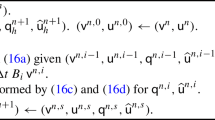Abstract
The front-tracking method for hyperbolic conservation laws is combined with operator splitting to study the shallow water equations. Furthermore, the method includes adaptive grid refinement in multidimensions and shock tracking in one dimension. The front-tracking method is unconditionally stable, but for practical computations feasible CFL numbers are moderately above unity (typically between 1 and 5). The method resolves shocks sharply and is highly efficient. The numerical technique is applied to four test cases, the first being an expanding bore with rotational symmetry. The second problem addresses the question of describing the time development of two constant water levels separated by a dam that breaks instantaneously. The third problem compares the front-tracking method with an explicit analytic solution of water waves rotating over a parabolic bottom profile. Finally, we study flow over an obstacle in one dimension.
Similar content being viewed by others
REFERENCES
F. Alcrudo and P. Garcia-Navarro, A high-resolution Godunov-type scheme in finite volumes for the 2D shallow-water equations, Internat. J. Numer. Methods Fluids, 16 (1993), pp. 489–505.
D. Ambrosi, Approximation of shallow water equations by Roe's Riemann solver, Internat. J. Numer. Methods Fluids, 20 (1995), pp. 157–168.
A. Bermùdez, A. Dervieux, J. A. Désidéri, and M. E. Vázquez, Upwind schemes for the two-dimensional shallow water equations with variable depth using unstructured meshes, Comput. Methods Appl. Mech. Engrg., 155 (1998), pp. 49–72.
A. Bressan, G. Crasta, and B. Piccoli, Well-posedness of the Cauchy problem for n × n systems of conservation laws, Mem. Amer. Math. Soc., to appear
A. Bressan and P. LeFloch, Uniqueness of weak solutions to systems of conservation laws, Arch. Rational Mech. Anal., 140:4 (1997), pp. 301–317.
R. J. Fennema and M. H. Chaudhry, Explicit methods for 2-D transient free-surface flows, J. Hydraul. Eng., 116 (1990), pp. 1013–1034.
A. E. Gill, Atmosphere-Ocean Dynamics, Academic Press, New York, 1982.
H. Holden, K.-A. Lie, and N. H. Risebro, A front tracking method for conservation laws in two dimensions, J. Comput. Phys., 150 (1999), pp. 76–96.
H. Holden and N. H. Risebro, A method of fractional steps for scalar conservation laws without the CFL condition, Math. Comp., 60(201) (1993), pp. 221–232.
H. Holden and N. H. Risebro, Front Tracking for Conservation Laws, Lecture Notes, Department of Mathematical Sciences, Norwegian University of Science and Technology.
G.-S. Jiang and E. Tadmor, Nonoscillatory central schemes for multidimensional hyperbolic conservation laws, SIAM J. Sci. Comput., 19:6 (1998), pp. 1892–1917.
J. O. Langseth, On an implementation of a front tracking method for hyperbolic conservation laws, Advances in Engineering Software, 26:1 (1996), pp. 45–63.
J. O. Langseth, N. H. Risebro, and A. Tveito, A conservative front tracking scheme for 1D hyperbolic conservation laws, in Nonlinear Hyperbolic Problems: Theoretical, Applied, and Computational Aspects (Taormina, 1992), A. Donato and F. Oliveri, eds., Vol. 43 of Notes Numer. Fluid Mech., Vieweg, Braunschweig, 1993, pp. 385–392.
R. J. LeVeque, Large time step shock-capturing techniques for scalar conservation laws, SIAM J. Numer. Anal., 22 (1985), pp. 1051–1073.
R. J. LeVeque, Clawpack software.
R. J. LeVeque, Clawpack User Notes, Applied Mathematics, Box 352420, University of Washington, Seattle, WA 98195–2420, Nov. 1995.
R. J. LeVeque, Wave propagation algorithms for multidimensional hyperbolic systems, J. Comput. Phys. 131 (1997), pp. 327–353.
R. J. LeVeque and K. M. Shyue, One-dimensional front tracking based on high resolution wave propagation methods, SIAM J. Sci. Comput., 16:2 (1995), pp. 348–377.
K.-A. Lie, Front Tracking and Operator Splitting for Convection Dominated Problems. Dr. ing. thesis, NTNU Trondheim, 1998.
K.-A. Lie, V. Haugse, and K. H. Karlsen, Dimensional splitting with front tracking and adaptive grid refinement, Numer. Methods Partial Differential Equations, 14:5 (1998), pp. 627–648.
R. Liska, L. Margolin, and B. Wendroff, Nonhydrostatic two-layer models of incompressible flow, Comput. Math. Appl., 29 (1995), pp. 25–37.
R. Liska and B. Wendroff, Composite schemes for conservation laws, SIAM J. Numer. Anal., 35 (1998), pp. 2250–2271.
R. Liska and B. Wendroff, 2D shallow water equations by composite schemes, J. Num. Meth. Fluids, to appear.
R. Liska and B. Wendroff, Analysis and computation with stratified fluid models, J. Comput. Phys., 137:1 (1997), pp. 212–244.
T.-P. Liu and J. Smoller, On the vacuum state for isentropic gas dynamics, Adv. Pure Appl. Math., 1 (1980), pp. 345–359.
A. T. Morel, A Genuinely Multidimensional High-Resolution Scheme for the Shallow Water Equations, PhD Thesis, Swiss Federal Institute of Technology, Zürich, 1997.
A. N. Nazarov, Mathematical modeling of a snow-powder avalanche in the framework of the equations of two-layer shallow water, Fluid Dynamics, 26 (1991), pp. 70–75.
N. H. Risebro, A front-tracking alternative to the random choice method, Proc. Amer. Math. Soc, 117:4 (1993), pp. 1125–1129.
N. H. Risebro and A. Tveito, Front tracking applied to a nonstrictly hyperbolic system of conservation laws, SIAM J. Sci. Stat. Comput., 12:6 (1991), pp. 1401–1419.
N. H. Risebro and A. Tveito, A front tracking method for conservation laws in one dimension, J. Comput. Phys., 101:1 (1992), pp. 130–139.
B. K. Swartz and B. Wendroff, AZTEC: a front tracking code based on Godunov's method, Appl. Numer. Math., 2:3–5 (1986), pp. 385–397.
W. C. Thacker, Some exact solutions to the nonlinear shallow-water wave equations, J. Fluid Mech., 107 (1981), pp. 499–508.
E. F. Toro, Riemann problems and the WAF method for solving the two-dimensional shallow water equations, Philos. Trans. Roy. Soc. London Ser. A., 338 (1992), pp. 43–68.
E. F. Toro, Riemann Solvers and Numerical Methods for Fluid Mechanics, Springer-Verlag, Berlin, 1997.
E. F. Toro and S. J. Billett, A unified Riemann-problem-based extension of the Warming-Beam and Lax-Wendroff schemes, IMA J. Numer. Anal., 17 (1997), pp. 61–102.
C. B. Vreugdenhil, Two-layer shallow-water flow in two dimensions, a numerical study, J. Comput. Phys., 33 (1979), pp. 169–184.
B. Wendroff, An analysis of front tracking for chromatography, Acta Appl. Math., 30 (1993), pp. 265–285.
Author information
Authors and Affiliations
Rights and permissions
About this article
Cite this article
Holdahl, R., Holden, H. & Lie, KA. Unconditionally Stable Splitting Methods for the Shallow Water Equations. BIT Numerical Mathematics 39, 451–472 (1999). https://doi.org/10.1023/A:1022366502335
Issue Date:
DOI: https://doi.org/10.1023/A:1022366502335




